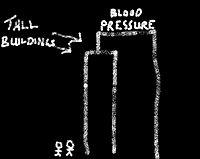Hypertension: Difference between revisions
No edit summary |
(→Risks) |
||
| Line 10: | Line 10: | ||
===Risks=== | ===Risks=== | ||
Nobody knows the exact cause of hypertension but there are some risk factors: | Nobody knows the exact cause of hypertension but there are some risk factors: | ||
*Diet - high salt, calcium and coffee intake | *Diet - high salt, calcium and coffee intake | ||
| Line 17: | Line 16: | ||
*[[HRT]] | *[[HRT]] | ||
Associated Risks: | |||
Hypertension is massively associated with [[cardiovascular]] disease which is why it is so important. It increase the risk of: | Hypertension is also massively associated with [[cardiovascular]] disease which is why it is so important. It increase the risk of: | ||
*[[stroke]] | *[[stroke]] | ||
*[[ischaemic heart disease]] | *[[ischaemic heart disease]] | ||
Revision as of 14:55, 25 March 2009
Definition
High blood pressure. According to NICE, it has to be persistenly over 140/90mmHg.
Epidemiology
Ridiculously high prevalence - 11.3%. 95% is primary (i.e. no known cause).
Pathophysiology
There are two types :
- essential (aka primary or systemic) - it just happens and nobody knows the cause.
- secondary - caused by another disease.
Risks
Nobody knows the exact cause of hypertension but there are some risk factors:
- Diet - high salt, calcium and coffee intake
- Genetics
- Oral contraceptive
- HRT
Associated Risks: Hypertension is also massively associated with cardiovascular disease which is why it is so important. It increase the risk of:
Clinical Features
The main clinical feature of high blood pressure is high blood pressure. Go figure. Well, I'm sure you did. This is about excluding secondary hypertension.
Classification
| Category | Systolic blood pressure (SBP) | Diastolic blood pressure (DBP) |
|---|---|---|
| Normal | ||
| Optimal | <120 | <80 |
| Normal | <130 | <85 |
| High normal | 130-139 | 85-89 |
| Hypertension | ||
| Mild (grade 1) | 140-159 | 90-99 |
| Moderate (grade 2) | 160-179 | 100-109 |
| Severe (grade 3) | >/=180 | >/=110 |
Obviously, in most patients, looking to get the BP to normal is what you aim for. However, there are certain populations where you need to aim lower. Check this shit!
| SBP | DBP | |
|---|---|---|
| Diabetes - no nephropathy | ||
| Intervention threshold | 140 | 90 |
| Target levels | 130 | 80 |
| Diabetes - with nephropathy | ||
| Target levels | 130 | 80 |
| Proteinuria (<1g/24h protein in urine) | 125 | 75 |
| Renal disease | ||
| Intervention threshold | 140 | 90 |
| Target | 130 | 80 |
| Chronic renal disease/proteinuria (see above) | 125 | 75 |
Investigations
These are more appropriate if secondary hypertension is suspected. I'd look at the secondary hypertension page if I were you.
Management
NICE and the British Hypertension Society (BHS) each came up with a set of guidelines regarding the management of hypertension. They came up with the algorithm on the right.
Hopefully, when to use ACE inhibitors (ramipril, lisonipril, enalapril), calcium-channel blockers (amlodipine, felodipine, nifedipine) and thiazide diuretics (usu. bendroflumethiazide) is obvious from the incredibly professionally drawn flow chart. Under the "clever other shit" moniker we have things like:
- Beta blockers - atenolol, propanolol, bisoprolol
- Angiotensin II receptor inhibitors/angiotensin receptor blocker (ARB)- losartan, irbesartan, valsartan
- alpha blockers - doxasozin
Basically, you try different drugs until you get their blood pressure to the target levels (or you give up and refer them to a specialist).
In diabetes (both types) with nephropathy an ACE inhibitor is recommeneded (with ARBs as an alternative). The same treatment should be used in chronic kidney disease. The benefit is beyond that of simply lowering blood pressure.

